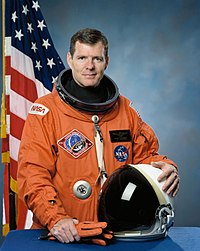Bryan D. O'Connor
| Bryan O'Connor | |
|---|---|

|
|
| Country: | United States |
| Organization: | NASA |
| selected on | May 19, 1980 ( 9th NASA Group ) |
| Calls: | 2 space flights |
| Start of the first space flight: |
November 27, 1985 |
| Landing of the last space flight: |
June 14, 1991 |
| Time in space: | 15d 23h 18min |
| retired on | July 29, 1991 |
| Space flights | |
Bryan Daniel "OC" O'Connor (born September 6, 1946 in Orange , California ) is a retired American astronaut .
O'Connor received a bachelor's degree in engineering from the United States Naval Academy in 1968 and a master's degree in aerospace engineering from the University of West Florida in 1970 .
O'Connor joined the United States Marine Corps in June 1968 . There he completed his training as a naval pilot in 1970 and as a test pilot in 1975 . As a pilot he was stationed in the USA, Europe and in the Western Pacific, as a test pilot he was mainly involved in the testing of vertical take-offs, such as the Harrier fighter aircraft .
Astronaut activity
In May 1980, O'Connor was selected by NASA as an astronaut candidate. He supported the first space shuttle missions in various areas. After the Challenger disaster , he was involved in their investigation. In March 1986 he became assistant to the space shuttle program manager and first chairman of NASA's new Space Flight Safety Panel. From February 1988 he was deputy head of the Flight Crew Operations department.
STS-61-B
On November 27, 1985, O'Connor started as a pilot of the space shuttle Atlantis for its first flight into space . During this mission, the three communications satellites MORELOS-B ( Mexico ), AUSSAT-2 ( Australia ) and SATCOM KU-2 were deployed. During two outboard activities, fellow astronauts Jerry Ross and Sherwood Spring tried out methods of assembling structural elements in space.
STS-61-M
The mission STS-61-M of the Challenger should have brought a TDRS satellites into space in July 1986th The crew would have consisted of Loren Shriver , Bryan O'Connor, Mark Lee , Sally Ride , William Fisher , the US industrial astronaut payload specialist Robert Wood and a meteorologist from the US Air Force (one of the group of three from Grant Aufderhaar, Fred Lewis, Ronald Townsend ) passed. This flight was canceled after the Challenger disaster.
STS-40
On June 5, 1991, O'Connor took off as commander of the Columbia Space Shuttle for the STS-40 mission . It was the fifth Spacelab mission, the first to focus solely on the life sciences. The most important experiment was Spacelab Life Sciences-1. Physiological studies were carried out on humans, 30 rodents and thousands of tiny jellyfish. Of the 18 studies, ten dealt with humans, seven with rodents and one with jellyfish.
After leaving the astronaut corps
In August 1991, O'Connor retired from NASA and became the commanding officer of the Marine Aviation Detachment at the Naval Air Test Center. In 1992 he returned to NASA headquarters in Washington and became Deputy Associate Administrator for Space Flight. In the summer of 1992 he became the head of the delegation in Moscow that negotiated the framework for the Shuttle Mir program. In March 1993 he became the director of the Space Station redesign. In this position he recommended substantial redesigns and savings in the International Space Station so that the project would not be canceled by Congress. In September 1993 he was appointed provisional director of the space station program until a full-time director was appointed in January 1994.
In April 1994, O'Connor was named director of the entire space shuttle program. In February 1996, he left NASA and worked for the private aviation company Airship Resources Corporation and the consulting firm Futron Corporation. In 2002, O'Connor returned to NASA to become head of the Office for Safety and Mission Assurance.
Private
Bryan O'Connor is married with two children.
See also
Web links and receipts
- Short biography of Bryan D. O'Connor at spacefacts.de
- NASA biography of Bryan D. O'Connor (English; PDF)
- Biography of Bryan D. O'Connor in the Encyclopedia Astronautica (English)
| personal data | |
|---|---|
| SURNAME | O'Connor, Bryan D. |
| ALTERNATIVE NAMES | O'Connor, Bryan Daniel; OC (nickname) |
| BRIEF DESCRIPTION | American astronaut |
| DATE OF BIRTH | September 6, 1946 |
| PLACE OF BIRTH | Orange (California) , California |